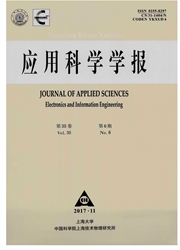

 中文摘要:
中文摘要:
为评估编码调制信号在实际无线信道下的性能,利用通用软件无线电外设(universalsoftwareradioperipheral,USRP)对Turbo码、二进制低密度奇偶校验(10wdensityparitycheck,LDPC)码、多进制LDPC码等3种信道编码方案的八进制相移键控调制信号实际性能进行对比分析.为保证译码器获得准确的先验信息,首先基于同步序列实现八进制相移键控系统相位模糊的检测和恢复;然后利用经验特征函数实现信道噪声方差的估计;进而计算出译码器输入符号的先验概率.仿真与测试结果表明,在较短的码长下,采用上述3种编码方式均可以获得优越的系统性能,并且多进制LDPC码的性能优于2进制LDPC码与Turbo码的性能.
 英文摘要:
英文摘要:
To evaluate the performance of coded and modulated signals in a wireless chan- nel, experiments are performed based on the universal software radio peripheral (USRP). Performances of coding and modulation schemes using 8 phase-shift keying and three chan- nel coding schemes, including turbo codes, binary low density parity check (LDPC) codes and non-binary LDPC codes, are compared and analyzed. To ensure accuracy of the apriori probability, phase ambiguity in the symbol of 8 phase-shift keying is detected and recovered based on frame synchronization sequences. An empirical characteristic function is used to estimate the channel noise variance. Furthermore, a priori probability is calculated from the recovered symbol and the estimated noise variance. Simulation and experimental re- sults show that, with short code length, superior performance can be achieved with the three channel coding schemes, and non-binary LDPC codes performs better than binary LDPC codes and Turbo codes.
 同期刊论文项目
同期刊论文项目
 同项目期刊论文
同项目期刊论文
 期刊信息
期刊信息
